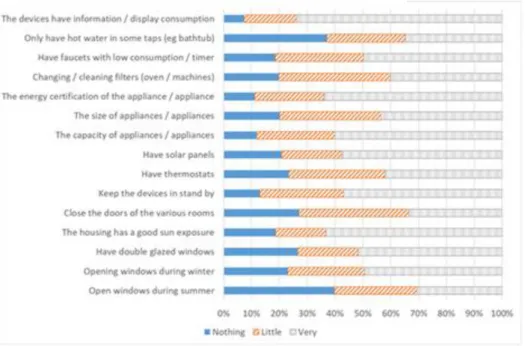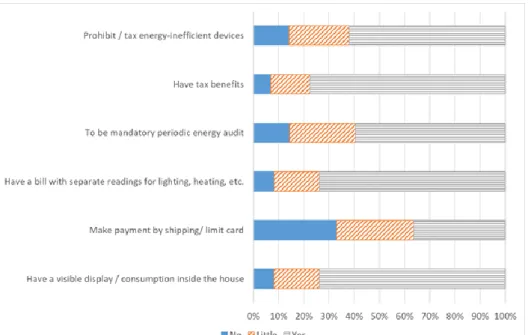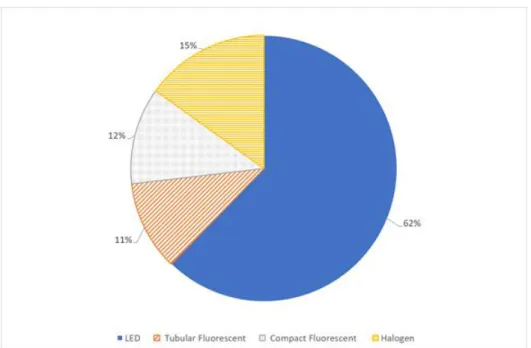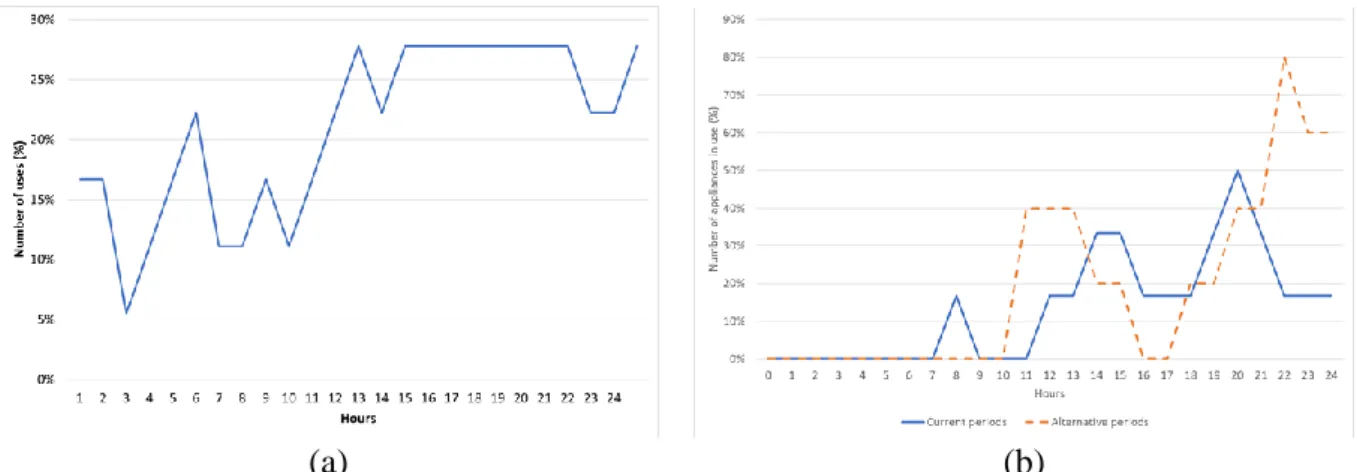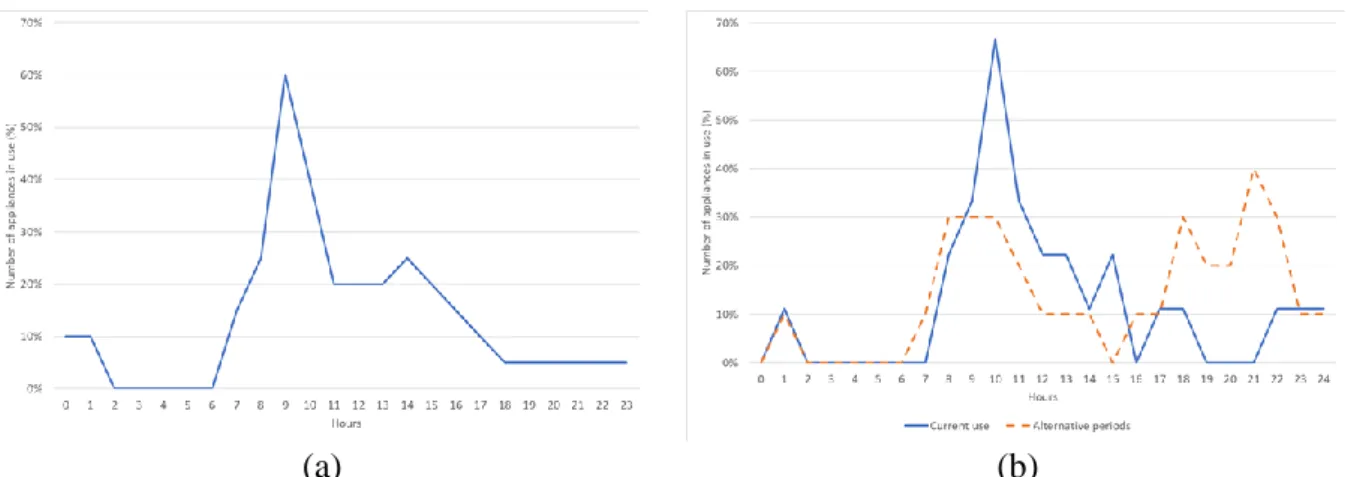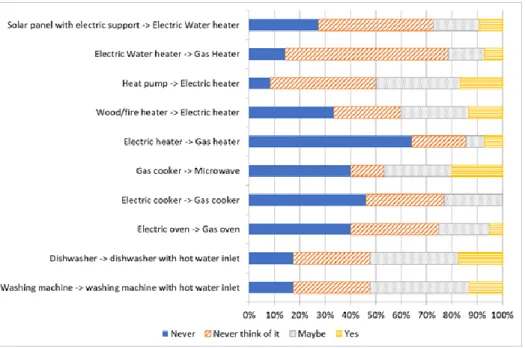1
Efficiency and Sufficiency in electric energy: a study with higher education
students
José L. Sousa*
School of Technology of Setúbal
Polytechnic Institute of Setúbal, Setúbal, Portugal INESC Coimbra - R&D Unit, Coimbra, Portugal
SustainRD, Setúbal, Portugal email: jose.luis.sousa@estsetubal.ips.pt
Jorge Junior
School of Technology of Setúbal
Polytechnic Institute of Setúbal, Setúbal, Portugal email: jorge.cabral.junior@estudantes.ips.pt
Alexandre G. Silva Coimbra Business School
Polytechnic Institute of Coimbra, Coimbra, Portugal email: : alexmfgs@gmail.com
Dulce H. Costa
School of Technology of Setúbal
Polytechnic Institute of Setúbal, Setúbal, Portugal INESC Coimbra - R&D Unit, Coimbra, Portugal
email: dulce.costa@estsetubal.ips.pt
ABSTRACT
Consuming less energy whenever possible and obtaining the same satisfaction with equipment or services we use does not depend exclusively on the efficiency of the appliance. The behaviour of the energy consumer itself plays a fundamental role in this process. The consumer behaviour is also what can help us to go from efficiency to sufficiency in energy use. The fulfilment of our energy needs reducing environmental externalities led us through the path of energy efficiency improvement options and rational use of energy - Energy sufficiency. In this paper we discuss some of the results obtained from surveys conducted with the aim of studying the electricity consumption behaviours of higher education students’ households. Its main objective was to characterize their willingness to change behaviours of what we expect to be well-informed individuals. These surveys are part of the Learn2Behave project that intend to characterize consumer’s behaviours and suggest new alternatives that will increase efficiency and sufficiency behaviours in electricity use. The results of the surveys indicate that there is some knowledge about increasing efficiency in electric energy use. The results of these surveys will inform the app “Minha Energia”, as a way to improve respondents’ literacy on energy efficiency and energy sufficiency related subjects.
KEYWORDS
Energy Sufficiency, Energy efficiency, Domestic Consumption, Behaviour, Education,
2
Electricity consumption in the Portuguese residential sector accounts for 26% of total consumption in per capita values and 32% regarding electric energy users, from 1994 to 2017 [1]. In Portugal, the residential sector is responsible for 17% [2] of the final energy consumption (in EU-28 it corresponds to 26%) [3]. Although being generally aware of importance of efficiency on energy consumption, Portuguese households invoke unawareness of the best energy-saving practices and the perception of already saving as much energy as possible as the main reasons to justify the gap towards a more efficient energy behaviours [4]. One can consider two types of energy consumption behaviours: infrequent ones, such as, the purchase of energy consuming equipment, and frequent ones, those behaviours associated with the use of equipment (lighting, cooking) [5]. The adoption of more energy efficient behaviours is not an easy task. Although, one may agree that more energy efficient behaviours should be adopted, barriers exist. One of the barriers is the perception of a reduction in the life quality [6].
This paper discusses the results of different surveys that were conducted to young adults, as part of a research project, named Learn2Behave, aiming to characterize residential energy consumption behaviours and disseminate good practices. The project uses a mobile application (app), called "Minha Energia" (the Portuguese for My energy), as an inquiry tool to characterize end-users’ behaviours, giving hints and advices to motivate and engage participants as a reward. The development involves students and researchers from three higher education institutions in Portugal, a research institute and three energy agencies
The study presented here intents to characterise how families with higher education students use electric energy, the perception they have on the consumption, and identify changes in electric energy use families are willing to do to take. Three different surveys were performed. In the next section some references are made to differences between energy efficiency and energy sufficiency. Then, some results of the three conducted surveys are presented, followed by a discussion and some conclusions.
ENERGY EFFICIENCY AND ENERGY SUFFICIENCY
Although energy efficiency measures have been promoted for the last decades, only recently the total energy consumption in OECD countries have been decreasing at a rate much slower than the expected by the energy efficiency potentials [7]. Energy Sufficiency as emerged as a way of limiting consumption.
According to [8] it is attributed to Wolfgang Sachs the idea that efficiency and sufficiency should be combined: “While efficiency is about doing things right, sufficiency is about doing the right things”. Some authors define energy sufficiency as a state in which the basic needs of people's energy services are met equitably and ecological boundaries are respected where the objectives to be met can be seen as policy actions to reduce energy consumption, in addition to improve efficiency [9]. Others define it as a reduction in the use of energy services, which aims to reduce energy consumption and the environmental impacts associated with these services [10]. Both these definitions have something in common, they reflect sufficiency as a method to achieve the main objective, the reduction of energy consumption and consequently the environmental impacts that it can cause. Energy efficiency, in technical therms, tell´s us how much usefull work or service, can we obtain from each unit of energy consumed. Very often the new and more efficienct appliance bought to replace the old one is bigger or of superior quality, consuming more energy than the old one. Improving the efficiency of appliances is not enough to reduce consumption. Besides the technical part, the expected reduction in energy consumption due to the purchase of new appliances may lead the consumer to change behaviour, increasing
3
consumption. For intance, the consumer may increase the indoor temperature from his new and more efficient boiler. This effect is knowned by rebound effect [11]. So energy efficiency may lead to behavioural changes and more energy consumption [12].
Energy prices and taxes can both foster or act as a barrier to energy efficiency and sufficiency. High energy prices are an economic motivation to save energy. This motivation may lead to improvements in energy efficiency and energy sufficiency. Energy taxation can then foster energy efficiency as well as sufficiency. However, energy prices overall may only help to overcome energy prices related barriers. The perception consumers have of their consumption and its correlation to comfort, for instance, is not addressed by price related measures.
Lack of information may also be a barrier to the adoption of energy efficiency and energy sufficiency measures. Personalized advice on energy sufficiency can be far more effective than general advertising information. The consumer must see himself in the advice he is recieving [12].
The use of gamification strategies as a tool to enhance information gathering regarding consumer behaviour is presented in the next section.
GAMIFICATION STRATEGIES AND CONSUMER BEHAVIOURS
Students and researchers of three higher education institutions in Portugal, a research institute and three energy agencies have been involved in the development of a mobile application (app) called "Minha Energia" (My energy, in Portuguese), as a tool to enhance information gathering regarding consumer behaviours, characterizing consumers’ behaviours, and giving suggestions and advices to participants as a reward [13]. These rewards are intended to act as incentives to participants, rewarding them for the data provided. This approach allows users to interact, allowing greater feedback from their experience [14]. The work was carried out as part of a research project (with the name Learn2Behave) aiming to characterize residential energy consumption behaviours, and to improve energy literacy of the participants seeking to contribute to improve energy efficiency and reduce energy bills.
The app can be downloaded from Play Store, being available to the general population, aiming to help to foster energy efficiency, promoting more energy efficient behaviours while considering energy sufficiency.
According to [15] some barriers that can hinder the improvement of energy efficiency can be classified as financial, technical and behavioural. Uncertainties related with cost/benefit analysis belong to the first type of barriers. For instance, the proper capacities/sizes, technical data and the user profile are considered technical barriers and can make it difficult to decide on the most appropriate choice. Behavioural barriers such as unawareness of the most advisable energy-saving practices and the perception of already saving as much energy as possible can hinder more efficient energy behaviours [4].
The use of game elements and strategies in non-game contexts to motivate and influence user behaviour [16] is called Gamification. The idea is to engage participants in a behaviour using a fun environment. Besides gamification, also serious games are used to motivate and enlighten consumer in energy consumption and related areas.
A review study [17] on the use of gamification and serious games in domestic energy consumption states that the use of these strategies are likely to produce short term behavioural changes. According to another review study [18] that analysed the use of serious games and gamification to pro-environmental behaviours for energy efficiency, awareness of the impact
4
of some behaviours on energy savings and efficiency can increase, as can the awareness on energy consumption, even in young individuals.
In [19] the authors alert that the use of smart electricity meters, which is an objective stated at EU Recommendation 2012/148/EU, is not enough to make the residential customers more aware of the impact of their behaviour on energy consumption. They demonstrate that the use of gamification can engage residential customers to take an active role in the use of energy applications, which can give them the willingness to control their energy behaviour and make decisions that can lead, to cost saving and carbon footprint reduction.
Although gamification can lead to behavioural changes, it is necessary to give extra stimulus to maintain the achieved changes. In [20] the authors conclude that even a well-informed consumer deviate from the ‘rational choice’ model of human behavior, in which one objectively weighs up the costs and benefits of all alternatives before choosing the optimal course of action. This study shows that even consumers who face strong material incentives, and/or possess knowledge and motivation patently sufficient to act in more sustainable ways, may struggle to shift their behavior in the desired direction, particularly over the longer term [20].
In the following section the results of the surveys are presented.
STUDY METHOD AND DATA
In this section the results of three different surveys that were conducted under the Learn2Behave project will be presented. The surveys were conducted with different questionnaires and different participants. In the following table the main characteristics of the surveys are presented.
Table 1 – Main characteristics of the conducted surveys
Survey ID Number of
participants
Main characteristic of the participants
Survey 1 620 Higher education students from a school of business
Survey 2 145 Higher education students with subjects related to electric energy
Survey 3 27 Higher education students with subjects related to electric energy.
Survey 1
These preliminary results mirror the ones we have obtained during 2018 with 620 respondents, conducted at Coimbra Business School under the course of Market Research. The survey was displayed in social networks. The results are presented in the following figures. The answers of the respondents regarding the influence of several situations on energy consumption are presented in Error! Reference source not found..
5
Figure 1 – Influence on energy consumption.
When asked about the influence of different situations on energy consumption, the respondents demonstrated been, in general, well informed. Nevertheless, respondents seem to neglect the importance of changing /cleaning filters to reduce consumption, having thermostats to control the temperature, and opening the windows in the summer during the night and avoiding opening them during the daylight.
The behaviour of the respondents towards some energy consumption situations is presented in
Error! Reference source not found.. It can be seen that, although respondents behaviour is
align with sufficiency principles, they may not be well informed about the influence of energy consumption and comfort, the advantages of cogeneration, the fiscal benefits of renewable energy, and the alternative tariffs available. These results are understandable since the area of studies is not related to electric energy.
6
The respondents’ considerations regarding some attitudes that may save energy is presented in
Error! Reference source not found.. It can be seen that information related measures, such
as “Have a bill with separate…” and “Have a display…”, are considered to be the most effective in inducing energy saving attitudes. Curiously enough is the fact that having tax benefits is perceived to be more effective than prohibition or taxes on inefficient devices.
Figure 3 – Respondents insight towards some attitudes to save energy.
Survey 2
A second survey was performed, resulting in 145 responses so far [13]. The geographic distribution of respondents is quite spread, with a particular focus on the three regions where the members of the Learn2Behave project team are located - Coimbra (18%) and Leiria (27%), in the centre of Portugal, and Setúbal (29%), in the south.
Some of the preliminary results presented in [13] are:
• 34% of the respondents do not know their own contracted power.
• 28% are unaware of the different tariff options, namely, time-of-use options.
• 49% never changed their tariff options neither changed their supplier due to lack of information or inertia.
• 78% already have LED lighting devices in their homes. • 8.3% still have CRT TVs.
• 66% of the respondents use washing temperatures above 30ºC (49% use 40ºC, 18% use 60ºC).
• 23.6% consider their home uncomfortable during winter. • 25% consider their home uncomfortable during summer.
• Regarding the latter two results, most cases of dissatisfaction are reported in Setúbal, mostly for summer, but also for winter.
7
Survey 3
The questionnaire was developed taking into consideration domestic activities involving energy consumption. These activities vary according to the household (number of inhabitants, ages, income, time spent at home, ...), climatic conditions, and consumption habits, among others. The questionnaire consists of three sections:
1. Consumer profile – regarding information that characterizes the consumer, such as: number of inhabitants, typology of the house, types of energy consumed, contracted electrical power, consumption and annual energy costs, ...
2. Use of electricity - this section was planned according to appliances and energy services typically used by Portuguese families, to obtain as much information as possible regarding household appliances, usage times, periods of use and periods for which they are willing to change the use of the appliance or the energy service it provide;
3. Attitudes towards the rational use of energy - in this part, respondents are asked about questions related to the rational use of energy.
The questionnaires were distributed to students that attended classes on issues related to energy efficiency and energy management, in two of the three (higher education institutions (HEI), namely in polytechnic institutes of Coimbra and Setúbal. This survey is expected to last for the next couple of years.
27 students participated in the survey. 74% were male and 40% were under 25 years of age. As we can see most respondents (70%) have the flat rate (Table 2) and the remain 30% a type of time-of-use (TOU) rate. 56% the lowest power supply (Table 3) meaning that there is no much need for powerful or permanent use of appliances.
Table 2 Number of families regarding the time of use tariff option. Number of families
(%)
Flat rate 19 70
Two time periods 7 26
Three time periods 1 4
Table 3 Number of families regarding contracted power Number of families (%) ≤3,45 kVA 14 52% 6.9 kVA 11 41% > 6.9 kVA 1 4% Not known 1 4%
When asked about the lighting technology, more than 60% of the installed lamps are of LED technology (Error! Reference source not found.). The preference for this technology of
8
lamps, that require an important investment, are an indicator that the respondents are aware that this technology is more efficient than the common alternatives.
Figure 4 – Relative umber of lamps installed.
Some respondents are exclusively students and live with their families or live in a rented house during the work days, for studying, and so with a minor concern regarding housing equipment. The respondents were asked about the periods of use of some appliances and on possible alternative periods to take advantage of TOU rates. Respondents indicate alternative periods for four different energy services: washing machines, dishwashers, ironing, and vacuum cleaning.
Regarding the use of washing machines, 25 of the respondents indicated the periods of use of the equipment, 17 of them with flat rate, and 9 indicated alternative periods, 3 of them with TOU rate. The relative number of uses in each hour of the day is presented in Figure 5 (a). The present time periods of washing machine use and the alternatives, indicated by the respondents that are willing to change is presented in Figure 5 (b).
9
Figure 5 - Time periods of washing machine use for all respondents (a) and for the respondents willing to change (b)
Interesting enough is the fact that the respondents indicated more and longer alternative time periods of appliance use than the indicated under current use. This is probably the reason for the intention of using the washing machines in periods of lower tariff price and results from the inability to decide for the more convenient alternative periods. Nevertheless, some appliances use are still is in peak hours.
Regarding the use of dishwashers, 18 respondents indicated the time of use of the appliance (Figure 6 (a)) and only 5 indicated alternative periods, 2 of them with TOU rate. The present dishwashers’ use curves and the alternatives indicated by the respondents are presented in Figure 6 (b).
(a) (b)
Figure 6 - Time periods of dishwasher use for all respondents (a) and for the respondents willing to change (b).
The respondents responded similarly to what they had done for the washing machines: more alternative time periods of appliance use than the indicated under current use and some uses are still in peak hours.
Regarding the use of iron, of the 22 respondents that indicate the time periods of use (Figure 7 (a)), only 7 were willing to change the time of use under a TOU tariff. The diagrams of iron current use and they intend to do after the change are presented Figure 7 (b).
10
Figure 7 - Time periods of iron use for all respondents (a) and for the respondents willing to change (b)
Regarding the use of vacuum cleaner, of the 20 respondents that indicate the time periods of use (Figure 8 (a)), only 10 were willing to change the time of use under a TOU tariff. The diagrams of iron current use and they intend to do after the change are presented Figure 8 (b)
(a) (b)
Figure 8 - Time periods of vacuum cleaner use for all respondents (a) and for the respondents willing to change (b).
Although respondents show some willingness to change the time of use of vacuum cleaner, the periods of time indicated will not allow them to take any advantage of the off-peak electricity price.
In Figure 9 some respondents behaviour towards a more energy efficiency and sufficiency use are presented. The fact that the installations do not usually went off due to overload having in mind that most of the homes have low contracted power (Table 3), probably means that inhabitants do not turn or leave appliances on simultaneously. Although more than 70% of the respondents said they were willing to change time of use periods, when asked for the alternative time periods for appliances use, only a small percentage of them did so.
11
Figure 9 – Some respondents attitudes towards rational use of energy
In Figure 10 are presented the results of the respondents’ answers when asked for their opinion regarding their willingness to implement changes in energy services technologies.
Figure 10 – Attitudes towards adopting alternative technologies
Some attitudes demonstrated by the results depicted in Figure 10 shows that respondents may not be perfectly aware of the importance of technologies towards a more rational use of energy. For instance, 50% of the respondents were available or admitted the possibility of being available to change from Heat pump to electric heater. On the other hand, also 50% were available or admitted the possibility of being available to change to washing machines and dishwashers with a hot water inlet.
CONCLUSION
Three different surveys were conducted to higher education students’ families of three Portuguese higher education institutions. The results of the surveys indicate that there is some knowledge about increasing efficiency in electric energy use, for instance the use of LED lights, maybe because this was a measure frequently addressed in social media.
The questions related to time of use of different appliances, although not directly related to energy efficiency nor to energy sufficiency, is an indicator of how well consumers are aware of their energy services use. It was also perceived that respondents may not be perfectly aware of the appliances use. In addition, they indicate longer time periods when asked for alternative time periods for appliances to be used, under a time of use rate.
If the given answers were the actually verified or the ones the respondents suspect should be the “right” ones, is not clear. Future surveys must address the issue.
Under the Learn2Behave project, the results of these surveys will inform the app “Minha Energia”, as a way to improve respondents’ literacy on energy efficiency and energy sufficiency related subjects. The feedback that the respondent will receive, besides targeting the situation described by the respondents, will identify respondents’ fragilities or miss conceptions on energy efficiency and sufficiency.
12
ACKNOWLEDGMENT
This work was supported by the Portuguese Foundation for Science and Technology under strategic project grant UID/Multi/00308/2019 and R&D project grant SAICT-POL/23651/2016 | LISBOA-01-0145-FEDER-023651, with the support of FEDER.
REFERENCES
1. Pordata, Portuguese data base – Pordata.
https://www.pordata.pt/Portugal/Consumo+de+energia+el%C3%A9ctrica+per+capita+tota l+e+por+tipo+de+consumo-1230-10020, 2019 [Accessed: January 2019]
2. INE and DGEG. 2010 Residential sector energy consumption survey (978-989-25-0130-7). from National Statistics Institute, 2011 [Accessed: January 2019]
3. Eurostat, Eurostat- Statistics Explained. Greenhouse gas emissions by industries and households, 2015 [Accessed: January 2019]
4. Marta Lopes, Carlos Antunes, Ana Reis and Nelson Martins. Estimating energy savings from behaviours using building performance simulations, Taylor and Francis, Building Research and Information, Volume 45, Issue 3, Pages 303-319, DOI: 10.1080/09613218.2016.1140000, 2017
5. Antunes, D. G. Energy efficient appliances and energy efficient behaviours: from consumer's assessment to behaviour intervention (Vol. 18). (M. Acosta, Ed.) New York: Nova Science Publishers, 2014.
6. Rui Gaspar, D. A. Sufficiency before efficiency: Consumers' profiling and barriers/facilitator of energy efficient behaviours. Journal of Cleaner Production, 134-142. doi:dx.doi.org/j.clepro.2017.07.75, 2017.
7. Thomas, S., Brischke, L.-A., Thema, J., & Kopatz, M. Energy sufficiency policy : an evolution of energy efficiency policy or radically new approaches?, 2015 [Retrieved: 18-4-2019, https://epub.wupperinst.org/files/5922/5922_thomas.pdf]
8. Sascha Samadi, M.-C. G.-J. Sufficiency in energy scenario studies: Taking the potencial benefits of lifestyle changes into account. Technological Forecasting & Social Change, 124, 126-134. doi:https://doi.org/10.1016/j.techfore.2016.09.013, 2017.
9. Fawcett, S. D. Energy sufficiency: an introduction - Concept paper. Energy Sufficiency
project, eceee, 2018 [Retrieved: 21-11-2018,
https://www.energysufficiency.org/libraryresources/library/items/energy-sufficiency-an-introduction/].
10. Steve Sorrell, B. G.. Energy sufficiency and rebound effects - Concept paper. Energy Sufficiency project, eceee, 2018. [Retrieved: 21-11-2018, https://www.energysufficiency.org/libraryresources/library/items/energy-sufficiency-and-rebound-effects-concept-paper/]
11. Bertoldi, P. Are current policies promoting a change in behaviour, conservation and sufficiency? An analysis of existing policies and recommendations for new and effective policies. ECEEE 2017 SUMMER STUDY - Consumption, efficiency & limits, Presqu'île de Giens, France, pp. 201-211, 2017.
12. Thomas, S., Brischke, L.-A., Thema, J., & Kopatz, M. Energy sufficiency policy: an evolution of energy efficiency policy or radically new approaches?, 2015 [Retrieved: 18-4-2019, https://epub.wupperinst.org/files/5922/5922_thomas.pdf]
13. Sousa, João M., Neves, Luís M., Silva, Catarina H., Silva, Alexandre G., Lopes, Marta A., Sousa, José L., et al, Gamification as a way to involve young adults in energy efficiency and sufficiency – a case study, eceee 2019, Summer Study Proceedings on Energy efficiency first, but what next?, 3–8 June, Hyères, France, 2019.
13
14. Grünewald, P., Diakonova, M., Zilli, D., Matousek, A., School, A. & Bernard, J. What we do matters – a time-use app to capture energy relevant activities. ECEEE Summer Study 2017 Proceedings, pp. 2085-2093, 2017
15. World Business Council for Sustainable Development. Energy Efficiency in Buildings - Transforming the Market, WBCSD, 2009
16. Werbach, K. & Hunter, D.. For the win: How game thinking can revolutionize your business. Wharton Digital Press, 2012
17. Johnson, D., Horton, E., Mulcahy, R., and Foth, M.. Gamification and serious games within the domain of domestic energy consumption: A systematic review. Renewable and
Sustainable Energy Reviews 73, pp. 249–264, 2017.
http://dx.doi.org/10.1016/j.rser.2017.01.134
18. Morganti, L., Pallavicinia, F., Cadela, E., Candelierib, A., Archettib, F., and Mantovania, F.. Gaming for Earth: Serious games and gamification to engage consumers in pro-environmental behaviours for energy efficiency. Energy Research & Social Science 29, pp. 95–102, 2017. http://dx.doi.org/10.1016/j.erss.2017.05.001
19. AlSkaif, T., Lampropoulos, J., van den Broek, M., van Sark,W., Gamification-based framework for engagement of residential customers in energy applications, Volume 44, pp 187-195, October 2018. https://doi.org/10.1016/j.erss.2018.04.043
20. Elisha R. Frederiks, Karen Stenner, Elizabeth V. Hobman, Household energy use: Applying behavioural economics to understand consumer decision-making and behaviour, Renewable and Sustainable Energy Reviews,Volume 41,2015, Pages 1385-1394, https://doi.org/10.1016/j.rser.2014.09.026
